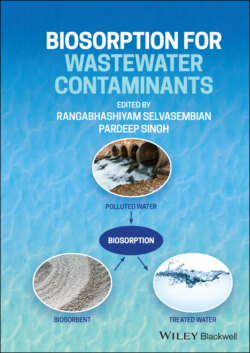Читать книгу Biosorption for Wastewater Contaminants - Группа авторов - Страница 28
Microbial Biomass as Biosorbents
ОглавлениеMicroorganisms that can tolerate harsh conditions have been used as biosorbents to remove metal ions from wastewater. Most of the microbial groups consist of functional groups that exhibit their ability as biosorbents. A significant number of materials with microbial originshave been studied extensively as biosorbents to remove metal ions. Based on their good performance, low cost, and large available quantities, microorganisms (bacteria, algae, yeasts, and fungi) are receiving increased attention for heavy metal retrieval. Experiments concentrating on the usage of dead and living microorganisms have been carried out to provide alternativetypes of remediation (Hlihor et al., 2014).
When the biosorption process first began to use microorganisms, researchers revealed that inactive/dead microbial biomass could passively bind metal ions. Dead biomass offers various advantages over live microbial biomass: cost‐effectiveness, toxicity limitation, ease of regeneration, displaying an exchange of ions, and a wide range of pH and temperatures (Adewuyi, 2020). Employing dead microbial biomass for metal ion binding is preferred over using alive biomass due to the lack of nutrient requirements and the management of biochemical oxygen demand (BOD) and COD in effluents. Therefore, the use of dead biomass is cost‐effective (Rezaei, 2016).
It became obvious that microbial biomass biosorption is based not only on the microbial biomass's chemical composition but also on external physicochemical factors and the chemical matrix. These biosorbents are capable of effectively retrieving metal ions from solution and efficiently decreasing parts per million (ppm) to ppb levels. As a result, they are thought to be good candidates for treating high‐volume, low‐metal‐ion‐concentration complicated wastewaters (Chen and Wang, 2006).
